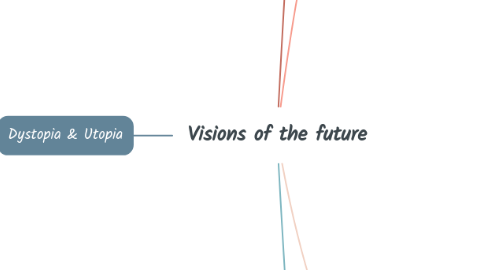
1. Dystopia & Utopia
1.1. Utopian Fiction
1.1.1. Challenges in Utopian Fiction
1.1.1.1. Who Defines Perfection?
1.1.1.2. Loss of Individuality
1.1.1.2.1. no personal identity
1.1.1.3. Hidden Dystopia
1.1.1.3.1. Fake perfection
1.1.1.3.2. oppression underneath
1.1.2. Definition
1.1.2.1. Idealized
1.1.2.1.1. government
1.1.2.1.2. economy system
1.1.2.1.3. social system
1.1.2.2. Imaginary perfect society
1.1.2.3. Harmony
1.1.2.4. equality
1.1.2.5. technological progress
1.1.3. Common Themes
1.1.3.1. Perfect Society
1.1.3.2. Scientific Advances
1.1.3.3. Gender & Social Equality
1.1.3.4. Environmental Balance
1.1.3.5. Freedom & Creativity
1.1.4. Examples of Utopian Works
1.1.4.1. Utopia (More)
1.1.4.2. The Dispossessed (Le Guin)
1.1.4.3. Star Trek
1.2. Dystopian Fiction
1.2.1. Definition
1.2.1.1. Negative outcomes for humanity
1.2.1.2. Imaginary future societies
1.2.1.3. Warning against trends
1.2.1.3.1. political
1.2.1.3.2. technological
1.2.1.3.3. social
1.2.2. Common Themes
1.2.2.1. Oppression
1.2.2.1.1. Lack of freedom
1.2.2.1.2. surveillance
1.2.2.2. Wars & Violence
1.2.2.2.1. global conflicts
1.2.2.2.2. Civil unrest
1.2.2.3. Corrupt Government
1.2.2.3.1. Totalitarianism
1.2.2.3.2. propaganda
1.2.2.4. Division in Society
1.2.2.4.1. Classes
1.2.2.4.2. discrimination
1.2.2.5. Hunger for Power
1.2.2.5.1. Dictatorship
1.2.2.5.2. corporate control
1.2.2.6. Limited Rights
1.2.2.6.1. Censorship
1.2.2.7. Rebellion
1.2.2.7.1. Resistance
1.2.2.7.2. underground movements
1.2.3. Causes of Dystopian Societies
1.2.3.1. Political Instability
1.2.3.1.1. Dictatorships
1.2.3.1.2. authoritarianis
1.2.3.2. Technological Control
1.2.3.2.1. AI dominance
1.2.3.3. Environmental Catastrophes
1.2.3.3.1. Climate disasters
1.2.3.3.2. resource wars
1.2.3.4. Scientific Manipulation
1.2.3.4.1. Genetic engineering
1.2.3.4.2. human experiments
1.2.3.5. Social Decay
1.2.3.5.1. Loss of morality
1.2.3.5.2. crime-ridden society
1.2.4. Examples of Dystopian Works
1.2.4.1. 1984 (Orwell)
1.2.4.1.1. Government surveillance
1.2.4.2. Brave New World (Huxley)
1.2.4.2.1. Consumer control
1.2.4.2.2. loss of individuality
1.2.4.3. The Handmaid’s Tale (Atwood)
1.2.4.3.1. Religious fundamentalism
1.2.4.3.2. women’s oppression
1.2.4.4. Fahrenheit 451 (Bradbury)
1.2.4.4.1. Censorship
1.2.4.4.2. destruction of knowledge
1.2.4.5. The Hunger Games (Collins)
1.2.4.5.1. Class oppression
1.2.4.5.2. entertainment violence
2. Genetic Engineering
2.1. CRISPR
2.1.1. Cure diseases
2.1.2. Modify DNA
2.1.3. Slow aging
2.1.4. Enhance humans
2.2. Ethical Issues
2.2.1. Super-soldiers
2.2.2. DNA manipulation
2.2.3. Irreversible changes
2.2.4. Unknown risks
2.3. Societal Impact
2.3.1. Genetic inequality
2.3.2. Rejecting "imperfect" people
3. Science & Technology
3.1. Historical Inventions
3.1.1. First tools
3.1.2. Fire development
3.1.3. Agriculture
3.1.4. Sailing ships
3.1.5. Printing press
3.1.6. Steam engine
3.1.7. Electricity & Light
3.1.8. Internet & AI
3.2. Future Technology
3.2.1. AI & Robotics
3.2.1.1. Superintelligence
3.2.1.2. Automation
3.2.2. Genetic Engineering
3.2.2.1. CRISPR
3.2.2.2. Designer babies
3.2.3. Space Travel
3.2.3.1. Colonization
3.2.3.2. Space tourism
4. Food Crisis
4.1. Causes
4.1.1. Conflicts
4.1.2. Climate change
4.1.3. Inflation
4.1.4. Resource shortage
4.2. Effects
4.2.1. Starvation
4.2.2. Migration
4.2.3. Political instability
4.3. GMOs as a Solution
4.3.1. Higher yield
4.3.2. Longer shelf life
4.3.3. Climate resistance
4.3.4. Lower prices
4.3.5. Reduced pesticide use
4.4. Ethical Concerns
4.4.1. Health risks
4.4.2. Biodiversity loss
4.4.3. Political control
5. Artificial Intelligence
5.1. Definition
5.1.1. Machines mimicking intelligence
5.1.2. Learning from data
5.2. Types of AI
5.2.1. ANI (Narrow AI)
5.2.1.1. Task-specific
5.2.2. AGI (General AI)
5.2.2.1. Human-like intelligence
5.2.3. ASI (Super AI)
5.2.3.1. Beyond human intelligence
5.3. Risks
5.3.1. Job loss
5.3.2. Deepfakes
5.3.3. Privacy issues
5.3.4. Bias in AI
5.4. Regulation Debate
5.4.1. Preventing misinformation
5.4.2. Ethical use of AI
5.4.3. Free access vs. control
